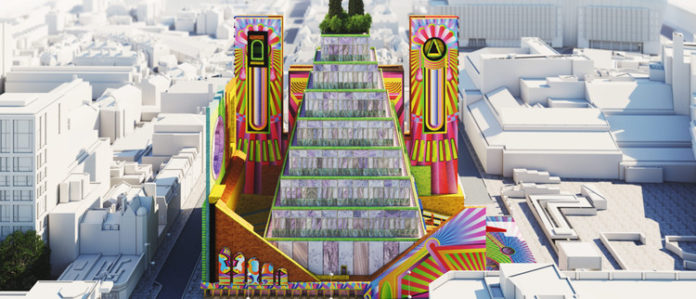
This article was originally published on Common Edge.
Stefan Fuchs & Raphael Dillhof interview Adam Nathaniel Furman and discuss the role and importance of facades in today’s urban fabric, “in the context of a broader range of social, economic, and political issues“. Part of a more in-depth study examining the role of facades in the 21st century, this discussion also raises the question of why buildings always embody the values of their creators.
In recent years the London-based artist and designer Adam Nathaniel Furman has emerged as a leading critical voice in British architecture. A graduate of the AA in London, Furman has focussed much of his work on the importance of diversity and representation in architecture, both aesthetically and demographically. This interview is part of a larger research project that examines the role of facades in the 21st century and discusses the impact of architecture on today’s urban culture. We talked about the prevailing aesthetics of “modernism,” his critique of the stagnant forces within architecture, and why buildings always embody the values of their creators. An extended version of this talk will be published in a forthcoming issue of ARCH+, the German magazine for architecture and urbanism, which will discuss building facades in the context of a broader range of social, economic, and political issues.
SF & RD(Stefan Fuchs & Raphael Dillhof): You could argue that most newer buildings today, as objects in the urban landscape, don’t embody any cultural value. Does this lack of imagery, this lack of culture, bother you?
ANF(Adam Nathaniel Furman): I would disagree. Buildings always embody the values of their creators, signify the role that they play in society, and hint at what (at least parts of) society considers worthy of celebration at any given moment in time. The glazed, transparent facades of the Apple store, the anonymous developer-facades of new civic buildings, the identikit, politely abstracted faux-contextualism of most current housing, the anti-monumental, nostalgic coziness of the new generation of cultural buildings—all indicate rather eloquently to the world a massive and profound schism between those who hold power, and who construct the world as we know it, and the reality of social structures that are changing in ways so radical that they leave the built environment looking like a freakish Stepford Wives–like modernist Disneyland, counterintuitively built to cater for a horde of punks, queers, fascists, beatniks, hippies, radicals, communists, libertarians, ravers. and fundamentalists, for whom one could not have imagined a more inappropriate context. Or, rather, one could not have imagined a context that would more perfectly stoke their rage and highlight their exclusion.
Buildings and the face they put forward to the city always express who they are for, and what society values—and currently in Britain, in the West, they explicitly value the conformity and unity of the old ruling class that rebuilt the continent after the war, and who still control the levers of power. They’re now either deeply nostalgic for the lost “consensus” of pre-immigration, pre-gay rights, pre-feminism, pre-everything-my-generation-values Europe; or they express the blank neutrality of placeless capital and bashful government that strains to hide its placelessness by wearing a minimal garb of regional identifiers. Both end up producing the same outcome: endless signs of deep nostalgia for the certainties of an uncomplicated, wealthy postwar consensus, and its congruent expression in modernism. This is fused with a yearning for times when we were all the same and everything was simple, expressed in an insipid and watered-down contextualism.

SF & RD: You’ve said this lack of expression in architecture and design is a conservative and “puritan” force that can also lead to the marginalization of minorities and other voices that are cut off from the mainstream. How can designers contribute to the formation of inclusive societies?
ANF: My interest has always been with regards to the acceptability—or its rejection—within the field of architecture of diverse modes of expression in the urban environment. In a healthy liberal democracy, there must be some sort of consonance between the variety of groups and peoples, identities and religions, cultures and politics, that are contained within the body of the people, and the variety shown within the various forms of communally visible expression. Whether it be in media of all kinds, newspapers, and television, or in the arts, and equally in business, finance and politics, and the law. In all these areas of the civic body, there must not be a disproportionate imbalance between those who constitute their respective professions, and the make-up of wider society. Otherwise, an imbalance occurs where—normally—the more marginalized groups have their interests, their stories, and their cultures sidelined. They’re sidelined because what is out of sight is always out of mind—and what is out of mind is never fully a part of society.
A healthy liberal democracy demands free and proud expression in full public view, at all levels of shared existence. Architecture and urbanism are the most prominent, visible, and potent expressions of civic identity, and as such, it is incumbent upon those who practice the shaping of our towns to ensure we create a context in which our cities become parliaments of vigorous aesthetic difference that embody the changing nature and makeup of our people. Instead, we have the precise opposite: planning laws, the ethnic and class makeup of the architectural profession, the power of heritage and localism lobbies, the dominance of gigantic development corporations, the condescending and totalitarian taste-cultures of the design community—all conspire to create an almost total tyranny of the majority, and tyranny of the “already-here,” in which there is absolutely no space for the difference of any substantial kind on our streets.
Just as gay architects can happily work in architectural practices these days, but by god they must not design buildings that are obviously, aesthetically, queer … they’re tolerated in the profession but absolutely not celebrated and allowed to express themselves. But they should be. Similarly, clients from a wealth of backgrounds should be able to have architects design buildings for them that create a constant and radical new stream of aesthetic expressions that relate to them uniquely, and not simply contain the functional quotidian logistics of their difference within the hegemonic tastefulness of normalizing, academic Westerners. I am not going to give specific examples, because I don’t want to get lost in criticizing this or that architect in particular. It’s about how aesthetics are a political battlefield of vital importance in the contemporary world, and the facade is the main weapon in the war. The new right knows this, which is why the architectural aesthetics of nativist Eurocentric nostalgia is such an important part of their project. But the left, and progressives in general, refuse to even recognize those aesthetics are meaningful at all, the result of which is that, on the one hand, there’s an incredible capitulation to nativist and localist nostalgic thinking (slightly abstracted, of course), and on the other the endless perpetuation of the (three or four) aesthetics of an exclusive and monolithic western academia, which act to erase and curtail all other forms of expression in a horrific and ongoing act of aesthetic imperialism.
SF & RD: Once seen as manifestations of democracy, the doctrines of Modernism failed to fulfill its self-proclaimed hopes to create a classless society. What clientele does modern architecture appeal to today? Has Modernism become an icon for the wealth of industrialized countries and powerful individuals?
ANF: The aesthetics of modernity are a symbol of the erasure of difference inherent in the spread of western academic and financial influence. The monstrous fusion of this with nativist tendencies in various places is its newest and perhaps most insidious guise to date, a form it takes in which it all the more aggressively erases any extant diversity. But this time it does so in the name of local identity and cohesion, all the while catalyzed by international normalizing thought and capital. Much like Trump who acts for the oligarchic class while being supported by the forgotten working class who are being most harmed by what he does, but for whom he claims all his actions are for. It’s the perfect Janus-faced architectural maneuver, in which the local supports its own destruction as it is consumed by its own image, powered by the very thing that wishes its destruction.

SF & RD: How can we counteract this? How can we build a more inclusive environment? Is it enough to counter Modernism with more ornament and color in architecture? Is it even possible to build differently in a world ruled by the aesthetics that you describe?
ANF: Of course it’s possible to build differently! And it’s possible to make a more inclusive symbolic environment, and we can do it with relative ease in terms of the practical steps to be taken, but the problem is that for these steps to be taken and to lead to any kind of true diversity would require a sea change in the way architects and designers think about their role. Architecture pretends to be progressive, but when it comes to its symbolic content, its aesthetics, it is essentially a religious edifice—which, because it serves no fundamentally utilitarian need and is almost entirely about aesthetics, is extremely fearful of its place in society and enforces its beliefs and dogmas on the rest of our culture and the economy with the same ironclad certainty that the priesthood did for an ailing Catholicism in the face of vividly heterogeneous modernity.
The fact that architecture designed by architects looks a particular and recognizable way (within an extremely limited range of difference), using a shared language into which all architects are indoctrinated and inculcated through education, is simultaneously their power as a priesthood of “decorum,” “order,” “quality,” and “depth,” and the reason that they’re one of the primary enemies of the democratization of our shared symbolic and physical spaces. Liberalization of the planning dogmas, so that there is a recalibration of power away from a de facto “tyranny of the majority” towards an enshrining of the rights of individuals and minorities to contravene conventional and architect-driven notions of “contextual” propriety (AKA urban xenophobia)—this is the fundamental structural shift that needs to occur. However, even if this were to happen, for a true field of newfound aesthetic urban deviation to flourish would require the design professions to face the fact that they have been presenting an extremely narrow set of options: Historically, the aesthetic preferences of a straight, male, academically celebrated figure that has now metastasized all over the world to become a straightjacket of stylistic hegemony). And they’ve done this as if that were the only true way, and that anyone else pursuing any other approach was somehow inferior—or, worse, pathetic or ridiculous. There is a reason that the Catholic Church did not want its followers to read the Bible because then they might interpret it in their own ways, and the given interpretation presented by the clergy was where the priesthood’s power lay: and so reading was suppressed. Similarly, as soon as members of wider society, as soon as women and queers and immigrants, and weirdos and misfits and mavericks, begin to understand that one can design however one wishes, even in the public realm, proudly, then architects in their black shirts and their Pritzker prizes be damned, and like priests, will lose their power. Against the wishes of the church, a once–deeply Catholic Ireland recently voted almost unanimously to legalize gay marriage, because the public saw through the lie that they had a monopoly on what was moral. Quickly may the day come when the false authority of architects, and its commensurate anti-democratic uniformity, collapse in much the same way.
SF & RD: Should the public be more involved in building design and urban planning, or does this lead to an even more watered-down compromise? Should they be able to build what others might not like?
ANF: Architects already often build what others do not like because most architects are designing to signal conformity and consensus with their peers above and beyond other concerns. It only so happens that at the moment, in pursuit of a contemporary obsession with “fitting in” and propriety, architects happen to be spewing out acres of sentimental, majority-pleasing glibness, but they could just as easily be once again forcing people into huge concrete blocks next month if their internal consensus dynamics were to reorient the professional herd. One can never please everyone, and that is not a goal that anyone should be working towards. In fact, it’s the opposite of what I’ve been talking about because when you try to please everyone, you necessarily end up replacing “everyone” with “the most people,” which means you once again serve up architectural majoritarianism and end up erasing any possible minority difference. It’s similar to public participation. Who has the time or energy to “represent” an area or a community? Do they really represent them? It’s almost always those with the most time, often those with the most unpleasant and bellicose pushy personalities—effectively, the bullies in the playground—who end up co-opting such processes and turning “public” participation into their very own little tyrannical fiefdoms. Either one has extremely sophisticated (I have never come across successful examples) processes for managing this—or it is best, in my eyes, to work on the actual profession, and as I’ve said earlier, make sure that it is internally blown to kaleidoscopic pieces with the introduction of every single type of different member of society, from all kinds of backgrounds, and that rather than being completely normalized in university and then in practice, so that the only trace left of their origins is in the body hidden under their shirts, we ensure that a parliament of approaches embodied in new aesthetics, truly representing difference, is fostered and brought through the profession into the fabric of the streets in our cities.
SF & RD: It seems that technical concerns have taken the place of ethical and moral questions. Is the prevalence of slick, plain, anonymous facades the result of a turn against authorship? And do you think that the democratization of technology—the affordability of it— will give new power to artists, architects, and designers?
ANF: Technical concerns are only used as a smokescreen to hide the fact that the decision to make these facades look this particular way is an aesthetic-ideological decision that masquerades as a functional one. There are many, many ways to make a facade that are cost-effective and thermally efficient. It’s a falsehood, the way supposedly “neutral” modern facades are presented as “technically efficient” solutions. They are anything but. They’re extremely hard and take a huge amount of energy and technical overcomplexity to achieve. It’s an actively perpetuated aesthetic lie that the profession identifies with and argues for, through sophistic misrepresentation. Bjarke Ingels’ famous sequential diagrammatic explanations of his projects are a good example of this kind of architectural presentation, in which irrational aesthetic choices are presented as logical and technical solutions. Technology is already giving more power to designers. My 2013–14 project Identity Parade at the Design Museum in London was all about this subject, but it’s a very limited form of freedom when it comes to the public. Just like total participatory democracy, there is a great flaw at the heart of everyone making everything for themselves, and it is simply that people do not have the time. In between working long hours, commuting to and from the office, picking up the kids, doing your taxes, managing your home, doing the shopping, paying bills, taking care of your sick relatives, seeing friends, and trying to have some kind of social life, there is simply no time for 99.9999999% of people to learn new tools and become experts in a new field. So while it will be great for a tiny minority of people, I do not at all see a broader public getting involved. When it comes to architects, there has never been a technical barrier to them doing as they wish. You only ever needed paper and a pe— and now a computer. The problem is in the religio-academic-aesthetic, socially exclusive gatekeeping edifice that the architecture world has become.









